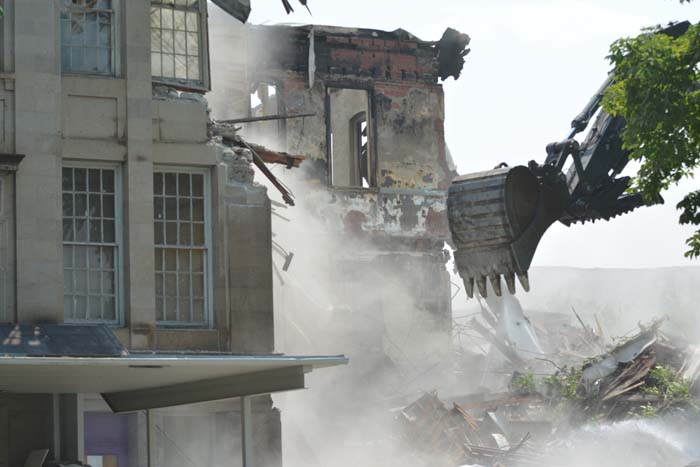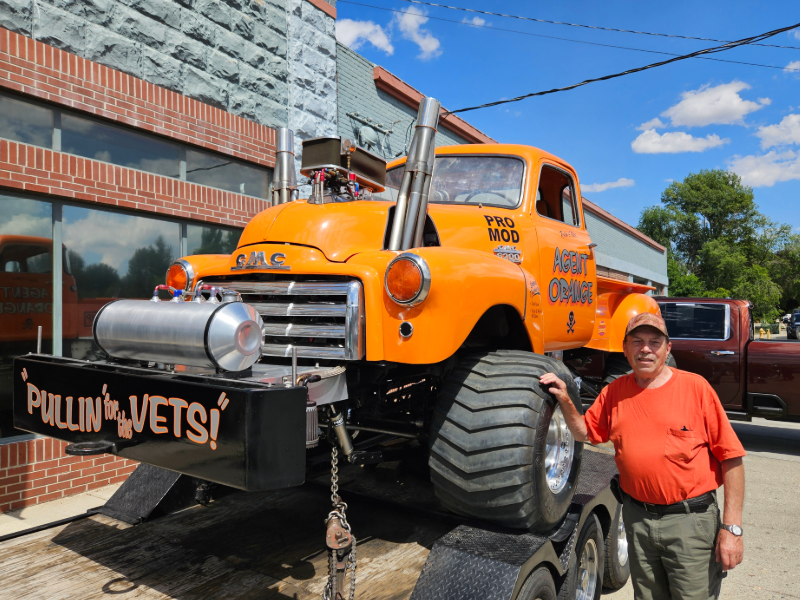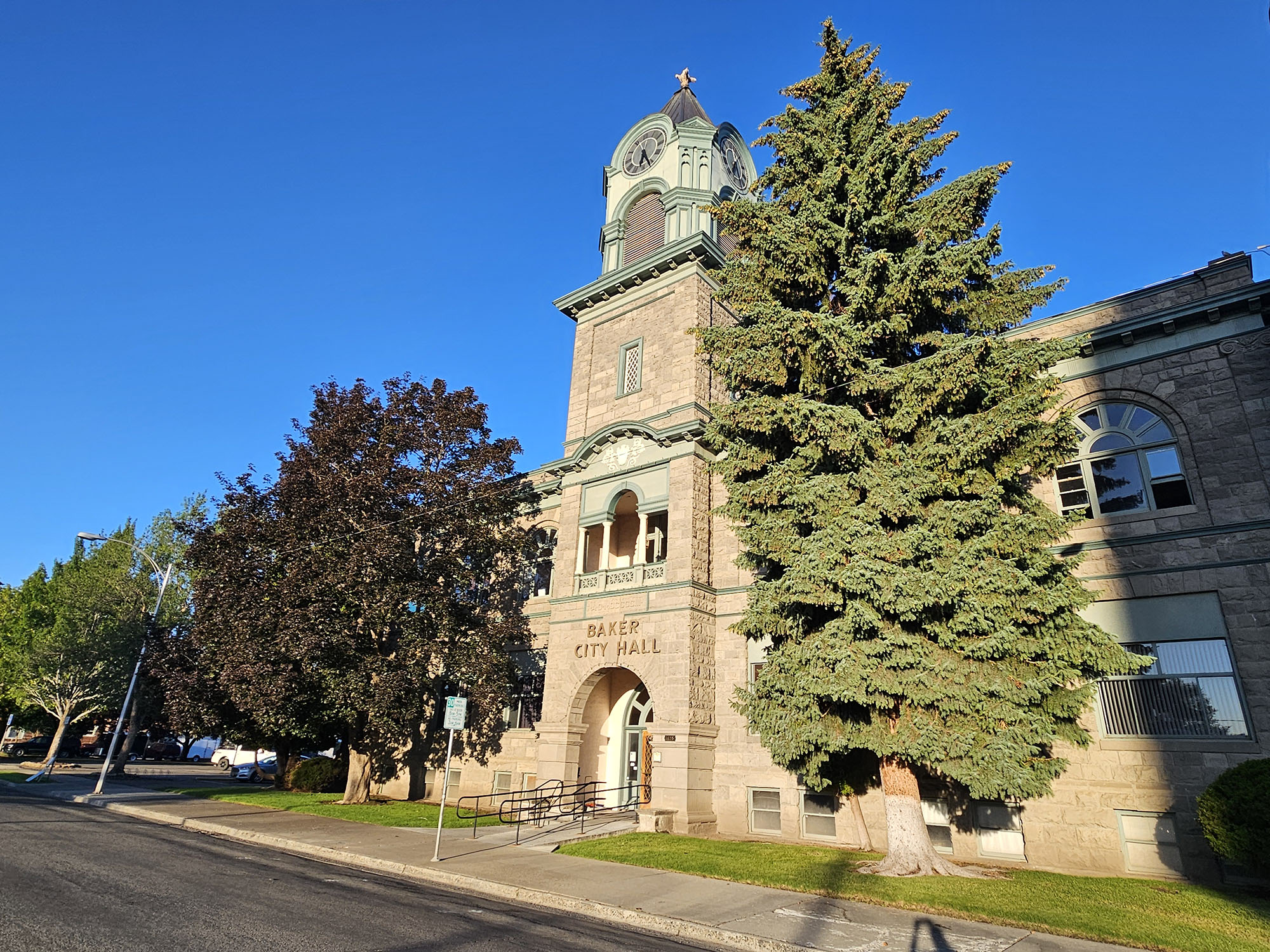Air sample test results from Central Building should be available late this week or early next week
Published 4:19 pm Wednesday, July 10, 2024

- A machine dismantles the northwest corner of the historic Central Building in Baker City on July 9, 2024.
A co-owner of the company that is demolishing the Central Building and hauling away building materials that contain asbestos said the firm is monitoring air at the site and he expects to have initial results from samples late this week or early next week.
Trending
Nick Segura, a former La Grande resident, is a co-owner of Alpine Abatement Inc. of Redmond, along with Joe Billings and Riley Billings, sons of Jack Billings, who founded the company in Tumalo, near Bend, in 1989.
Segura is Jack Billings’ son-in-law.
Workers brought down the three-story building’s exterior walls on Tuesday and Wednesday, July 9 and 10.
Trending
A fire, which is still under investigation, gutted the 106-year-old building on May 22.
The building, which served as Baker High School from 1917-52 and later was part of the middle school campus, closed in 2009.
Baker Technical Institute had been renovating the building, including installing a new roof last year and early this year, and had secured a federal grant to remove floor tiles and pipe insulation that contains asbestos, a naturally occurring mineral that, in airborne fiber, can lodge in people’s lungs and cause cancer.
But the fire severely damaged the building’s interior metal and wooden structure.
The Baker School District hired Alpine Abatement on a $1.1 million contract.
District officials hope an insurance payment and remaining grant dollars will pay for most or all of the Alpine Abatement contract.
‘High-profile job’
Segura said that although Alpine Abatement has done dozens of both demolition and asbestos removal jobs, the Central Building is somewhat unusual given the size of the structure and its location in a residential neighborhood.
Most demolitions are in industrial areas, he said.
“It’s a spectacle, and we know people are watching,” Segura said. “We really want to provide people with whatever information they want, and that they understand what’s happening. It’s a high-profile job.”
He hopes the air sample test results, from a Portland lab, will help alleviate any concerns among residents about asbestos.
Segura said the lab is testing air samples collected from devices that Alpine Abatement employees wear on their protective suits, as well as samples upwind of the building and downwind.
The results from those samples will be run through a mathematical formula to determine a “time-weighted eight-hour average” of any particulates in the air, including asbestos fibers, he said.
Segura said the company is required by state law to ensure asbestos fiber concentrations are below 0.1 fibers per cubic centimeter of air in the area where workers are assigned.
He said he would be “very, very surprised” if air samples on the site, including the downwind sensors, contain asbestos fibers.
The reason, Segura said, is that the flooring tiles and pipe insulation make up such a tiny fraction of the building, and the rubble from the demolition.
He said that based on his experience with many projects, that vast majority of the dust created during the demolition this week was from the tuffstone blocks that made up the building’s exterior, and the mortar that held them together. Those materials don’t contain asbestos, Segura said.
He acknowledged that the demolition has broken other materials, such as flooring tiles, that do contain asbestos. But he believes the amounts are so small that even if some fibers are collected in the air samples taken to the lab, the concentrations will be well below federal exposure limits.
Segura said the destruction of the exterior walls on Tuesday and Wednesday was “the dustiest part” of the job, with chunks of wall tumbling 20 feet or more to the ground.
By contrast, when workers start gathering the rubble, which will be hauled by trucks to a landfill, they’ll be able to control the material more closely, and also direct streams of water on each load to tamp any dust.
Baker City Manager Barry Murphy said city officials have fielded concerns from people who live near the Central Building regarding dust and potential asbestos exposure.
Murphy said he talked with Segura before the demolition started, and that Segura told him he did not expect the demolition to release hazardous amounts of asbestos.
Murphy said he hopes the air sample test results will help to ease residents’ concerns.
Greg Woydziak lives across Court Avenue from the Central Building.
Woydziak said he believes the workers “fell short” on suppressing dust with water on Tuesday, the first day of the demolition, but that they did better with that aspect on Wednesday, with as many as three hoses spraying the rubble.
Murphy said the city made a second fire hydrant available to Alpine Abatement on Wednesday.
Woydziak said he understands that it’s not possible to knock down a three-story building without creating dust. He said he is eager to see results from the air sample tests.
He said he wore a mask when he was outside on Tuesday, and has kept his doors and windows closed.
Salvaging stone
Segura said he hopes that some of the tuffstone can be saved and potentially made available to the public for decorations, although that’s not a decision his company can make.
“We understand the historical sensitivity of the project, and we want to save whatever we can save,” he said.
Segura said the stone, which was quarried near Pleasant Valley and is used in several other historic Baker City buildings, including City Hall, the Courthouse and St. Francis de Sales Cathedral, would be ideal for lining a garden path or some similar purpose.
Workers saved the time capsule in the building’s cornerstone at the northeast corner, he said.
Segura said they also hope to retrieve the section of wall from the north side on which is engraved: “Baker High School 1916.”









